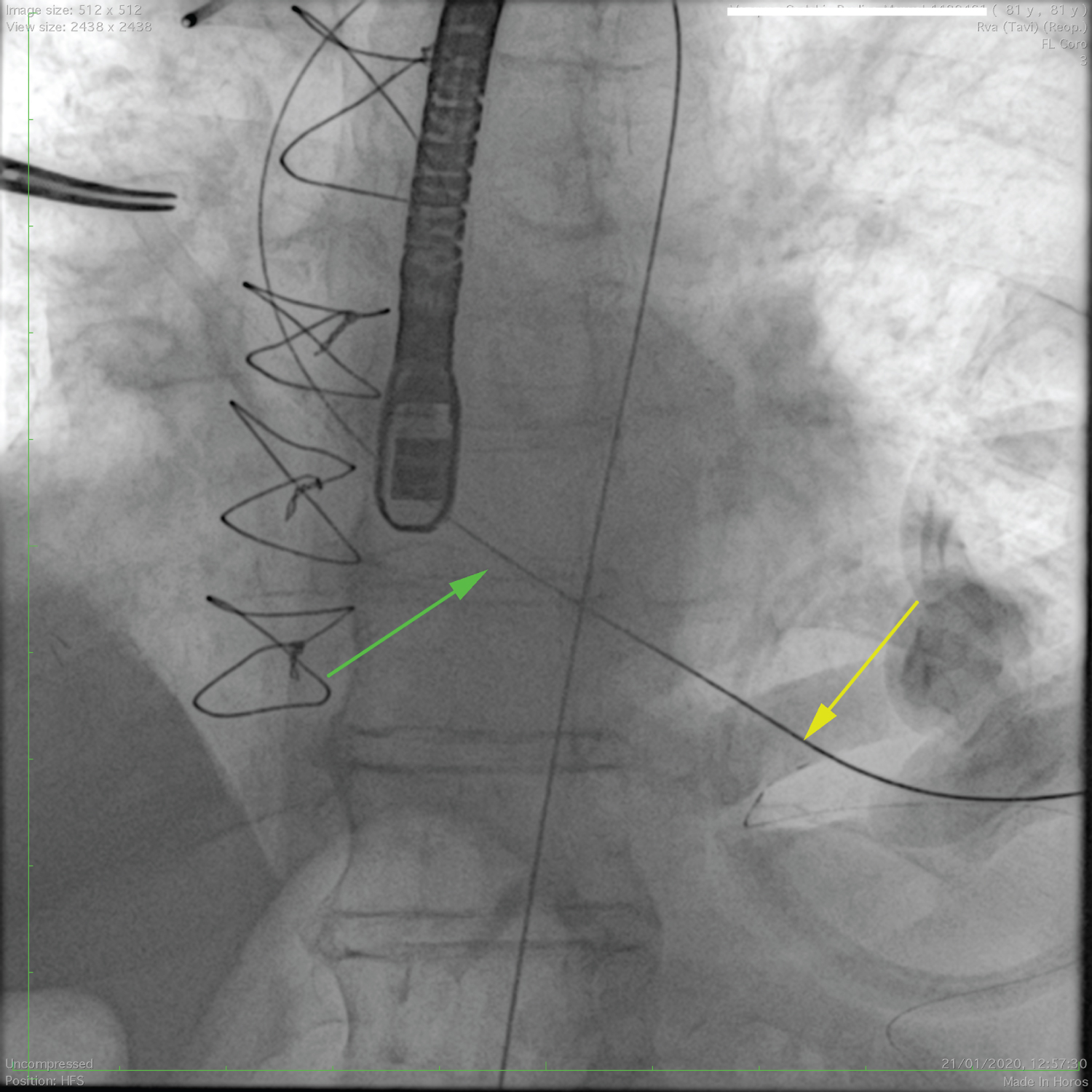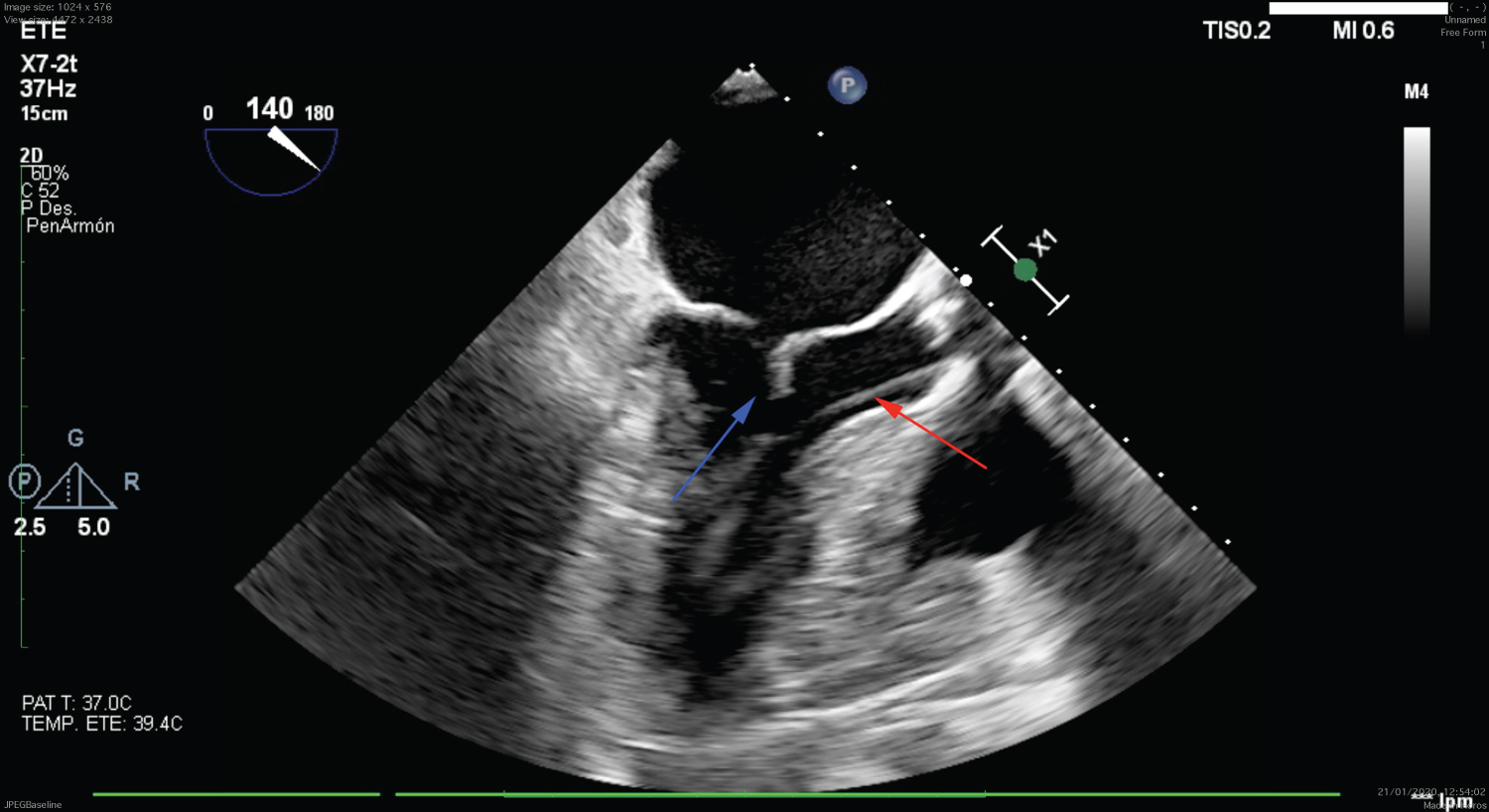The "Skipping Rope" Phenomenon in Transapical TAVI as a Cause of Reversible Mitral Regurgitation
Abstract
Mitral regurgitation is a complication that may occur during transcatheter aortic valve implantation (TAVI) and may require different treatments depending on the mechanism. In this report we describe for a "skipping rope sign" in transapical TAVI as a cause of severe mitral regurgitation due to extreme tethering of the anterior mitral leaflet caused by an extra-stiff guidewire entangled in its chordae tendineae during a transapical TAVI.
Keywords
Transapical TAVI, Complications, Mitral regurgitations
Introduction
Mitral regurgitation (MR) is a complication that may occur during transcatheter aortic valve implantation (TAVI) and may require different treatments depending on the mechanism [1]. Its incidence varies between 8.5% to 10.5% probably due to different criteria in evaluation among studies [2]. In this report we describe the "skipping rope" sign of a guidewire in transapical TAVI as a cause of reversible severe MR.
Description
An 81-year-old patient with history of previous coronary surgery, stroke and severe peripheral arterial disease was referred to transapical TAVI due to a symptomatic severe aortic stenosis. After crossing the aortic valve and exchanging a conventional guidewire for an extra-stiff guidewire through a standard transapical approach, the patient developed hemodynamic instability without rhythm disturbances. In the fluoroscopy, the position of the extra-stiff guidewire was correct through the aortic valve yet its trajectory in the left ventricle was too curved, resembling a "skipping rope" (Figure 1 and Video 1). Transeosophageal echocardiography (TEE) identified a new onset severe MR secondary to extreme tethering of the anterior mitral leaflet (AML) (Figure 2 and Video 2) caused by the extra-stiff guidewire that was entangled in the AML chordae tendineae. The guidewire acquired this "skipping rope" disposition in the left ventricular cavity because it was abnormally fixed at two points, namely, its origin in the transapical entrance point and entangled in the AML chordae tendineae. Mitral function was immediately restored after withdrawing the extra-stiff guidewire (Video 2) that allowed recovering the normal coaptation of both mitral leaflets. The guidewire was repositioned again through the aortic valve avoiding the mitral subvalvular apparatus. The transapical TAVI with a balloon- expandable prosthesis was completed without incidences.
Discussion
Mitral regurgitation may occur during TAVI either primary as a deleterious interaction in mitral valve morphology or function or secondary as an impairment in the left ventricle function and left ventricle dilatation [3]. Reported mechanisms [1-4] include structural damage of the mitral valvular or subvalvular apparatus, impingement of the aortic prosthesis on the AML, rupture of the chordae tendinae, systolic anterior movement of the AML, and biventricular a synchronic mechanical contraction owed to right ventricle pacemaker stimulation among others. Some of these mechanisms are transient and reversible, while some of them may condition a definitive severe MR that will obscure the patient’s prognosis.
In our report, the MR was caused by remarkable tethering of the AML by the entangled extra-stiff guidewire. Nonetheless, the particularity of this report is the "skipping rope" disposition that the guidewire acquired because it was fixed at two separated points yet, at the same time, loose enough in the ventricular cavity to resemble a "skipping rope" morphology. This sign is unique of the transapical access for TAVI. In fact, the transapical approach warrants a faster and easier antegrade crossing of the aortic valve than the retrograde approaches. However, in transapical access the probability of impairing either the integrity of the subvalvular mitral apparatus or its functionality is greater than in the retrograde approaches. Furthermore, this malposition of the guidewire not only caused severe mitral valve dysfunction, but it would have also precluded the correct navigation of the delivery system.
Finally, this case emphasizes the paramount importance of TEE guidance in TAVI that allows to rapidly identify complications that, otherwise, would have been overlooked with simple fluoroscopy guidance. Besides, in contrast to other cardiac interventional procedures, TEE-related complications during TAVI ranges between 0.2% to 1.4% [5], which is in line with its reported incidence in conventional open heart surgeries.
Authors Declaration
The authors state that there are no potential conflicts of interest to be considered in this article.
This manuscript describes original work and is not under consideration by any other journal.
All authors approved the manuscript and this submission.
The patient signed up the written consent approved by the Institutional Review Board, allowing the publication of his clinical images and data.
References
- Kappetein AP, Head SJ, Genereux P, et al. (2012) Updated standardized endpoint definitions for transcatheter aortic valve implantation: The Valve Academic Research Consortium-2 consensus document. Eur J Cardiothorac Surg 42: 45-60.
- Lopez-Aguilera J, Mesa-Rubio D, Ruiz-Ortiz M, Delgado et al. (2014) Mitral regurgitation during transcatheter aortic valve implantation: The same complication with a different mechanism. J Invasive Cardiol. 26: 603-608.
- Hahn RT, Gillam LD, Little SH (2015) Echocardiographic imaging of procedural complications during self-expandable transcatheter aortic valve replacement. JACC Cardiovasc Imaging 8: 319-336.
- Shibayama K, Harada K, Berdejo J, et al. (2014) Effect of transcatheter aortic valve replacement on the mitral valve apparatus and mitral regurgitation: Real-time three-dimensional transesophageal echocardiography study. Circ Cardiovasc Imaging 7: 344-351.
- Freitas-Ferraz AB, Rodes-Cabau J, Junquera Vega L, et al. (2020) Transesophageal echocardiography complications associated with interventional cardiology procedures. Am Heart J 221: 19-28.
Corresponding Author
Victor X Mosquera, MD, PhD, Department of Cardiac Surgery, Complejo Hospitalario Universitario de A Coruña, As Xubias n°84, CP 15006, A Coruña, Spain
Copyright
© 2022 Mosquera VX, et al. This is an open-access article distributed under the terms of the Creative Commons Attribution License, which permits unrestricted use, distribution, and reproduction in any medium, provided the original author and source are credited.






